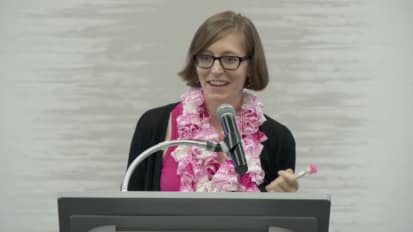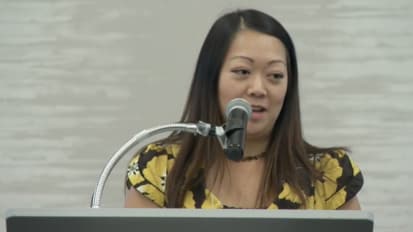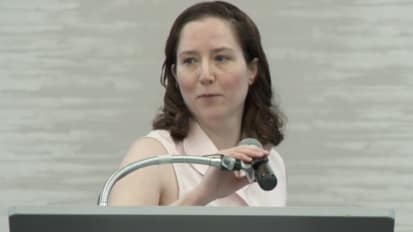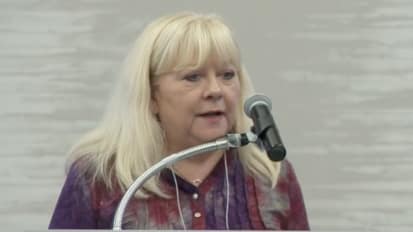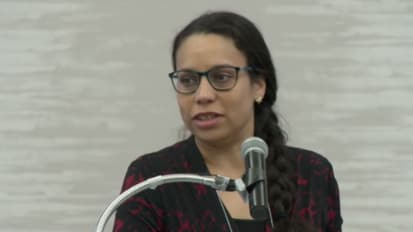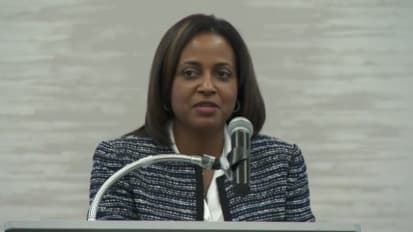Chapters
Transcript
We're going to talk a little bit about breast density this morning and what it means and if it really matters to patients. So I have no financial disclosure to discuss. But like Dr. [INAUDIBLE] said, I do have a personal disclosure, which is a three week old baby at home. So if I--
[AUDIENCE APPLAUSE]
If I start talking baby talk or fall asleep, just throw something at me and I'll kind of get back in gear. But let's start talking about breast density. This whole thing started around 2004 with a patient named Nancy Capello. This woman is a physician, and she was diagnosed with stage three invasive breast cancer about three months after having a completely normal mammogram.
And when she went to her doctor they said, well, you have dense breast tissue. And she said, well, what do you mean? Nobody's ever talked to me about this. She'd never heard of it.
So she went on to create this whole website and this whole movement. And it's called areyoudenseadvocacy.com. And you can go to her website and see what she tells patients and her experience of what happened with her. So we weren't trying to keep this a secret, but she went on to call breast density the best kept secret in medicine. She had no idea of anything about it.
Here's a little sampling. As if screening mammograms couldn't get any more controversial, we're going to add breast density in the mix. So just a sampling from the "New York Times" a couple of years ago, dense breast can obscure mammogram results. They may give you a higher cancer risk. They may not if you've got dense breast.
And certainly patients with dense breasts, their mammograms can be more difficult to interpret. So that's just, like I said, a few articles from the "New York Times" that we see.
So in Dr. Capello's fight for getting this into the light-- shedding some light on breast density-- she's gone on to-- she lives in Connecticut-- and they went through this whole process to inform patients of the breast density. And it's been sweeping the nation.
Currently, there's 24 states that have laws in place that say we as radiologists need to inform patients of their breast density. And there's about 10 more with legislation in process, and there's a website you can go to. It's interactive, and it changes in real time. So if somebody passes something new, it'll tell you exactly what it is. And you can go and click on whichever state you're interested in and see what exactly they're recommending.
Here in North Carolina this is-- if a patient has a screening mammogram, this is the letter they're going to get talking about the breast density. And the important thing is they give you a website to go to if you're a patient, but here's the thing. If you've got heterogeneously dense or extremely dense breast tissue, they should talk to a doctor about alternative screening strategies.
So patients are going to be coming to you. If you're in the primary care or breast specialty, they're going to be asking about, OK, I've got dense breasts, now what do I do? And this was one of the problems back in 2004, because we kind of got ahead of ourselves.
We didn't have the research. We didn't know what to recommend to patients, so it left us in a tough spot. We're going to go through some research later that tells you what we currently recommend and what our options are. So you'll be informed if anybody reaches out to you with that question.
So rewinding a little bit, this is what we see on a mammogram. And I'll take you through a little bit of the anatomy. It's pretty basic.
So there is fat in the breast, and then there's these glandular elements. So fat like anywhere else in the body is going to be dark or radiolucent on the mammogram. And all of these other elements are going to be white and/or radiodense. And it's that more dense tissue that we worry about that can obscure a mass or a lesion in the breast.
You can see we've got varying degrees of density starting from fatty over here and more and more dense. And certainly you can see, if you've got a small cancer in there it would be more difficult to see in the more dense breast tissue.
We have a certain lexicon we have to adhere to in mammography, and this is the words that you'll see on screening mammograms. This is what we'll say. So in this patient, they have almost entirely fatty tissue so the breasts are almost entirely fatty. And the mammograms are very good at picking up small cancers, early cancers here. You can see there's not a lot of tissue that could obscure a mass.
And we're going to go through with increasing density. So there are areas of scattered fibroglandular density. The breast or heterogeneously dense, which may obscure small masses, and then the breasts are extremely dense which lowers the sensitivity of mammography.
So this is our lexicon. We, a few years ago, went through a recent change. This is our most recent-- whoopsie, sorry-- our most recent BI-RADS 5 edition. So basically, they went from classifying how dense you are in terms of 0% to 25% glandular tissue. 25-% to 50%, 50% to 75%, 75% to 100%. So it was just how much glandular tissue versus how much fatty tissue. Well, they wanted us to change that.
So basically, now they recommend we give the density based on the most dense areas. So what they're really having us focus on is that most dense area that could possibly obscure a mass. So somebody could be really pretty fatty.
But say, if the subareola regions is very dense, they want us to report that and say, yes, the breast tissue is heterogenously dense and we could miss a small mass there. So that's just been a little recent nuance that's changed a little bit for us.
So where do our patients fall when we're looking at screening mammograms? The majority of our patients are going to fall in this. These patients are scattered fibroglandular densities. These are heterogeneously dense. So 80% of our patients are falling in this range.
So really, when you're talking about the mostly fatty breast or these extremely dense breasts, it's a bell-shaped curve. So there's 10% that are kind of outliers on either side. So the majority of people are scattered fibroglandular densities or heterogeneously dense.
So talking about breast density as a risk factor, what are we actually thinking about? So are they an increased risk of getting breast cancer? Are they an increased risk of us calling them back and doing additional imaging?
Or are they an increased risk of having a falsely negative mammogram or having an interval answer? So is it something that we could potentially miss on a mammogram? So we're going to kind of go through all these.
So our research started back in the early to or, I guess, the late 1990s. There was a man named Boyd and he made his own classification system, which we've changed a little bit. But the idea is the same that as you get these more dense breasts, you're going to increase risk of cancer inherently, because you've got more of those stromal elements. So more ducts and more things that can, theoretically, is where we're thinking the cancers could potentially start.
So he had a subsequent study. He reports anywhere between three to 5 and 4% to 6% increased risk of cancer. And so he went on to say dense breast tissue is one of the strongest risk factors for breast cancer, even greater than family history which is pretty-- that's pretty significant. Even if we only have 10% of people that have this extremely dense tissue, if you think of the volume of those patients in the screening population, that turns out to be a significant number of women that are at risk.
Now, when we actually look and go back and see how he got these numbers, we can see that he actually compared the risk of women getting breast cancer to these almost entirely fatty patients. So they have the lowest risk of getting breast cancer. If you actually compare these extremely dense patients to the scattered fibroglandular tissue, their risk is not that significantly increased. It's 1.2 times greater than those patients with scattered fibroglandular density.
So it may have been initially exaggerated. It certainly is slightly higher, and we need to be cognizant of that. But it's not quite as high I think as we had initially thought.
So screen detection rate, you can see that we are detecting breast cancers in all densities. And theoretically, we should be seeing a few more cancers here if you think that they do get more breast cancers in this range. So really, we are probably missing some cancers. So there are some things that we can potentially do as imagers to try and detect more of these cancers and not have them present with clinical symptoms.
And so in terms of recall rates, we actually call these patients with extremely dense breast tissue back less than their cohorts. So you can see if you've got these nice fatty breasts, your risk of getting called back is very low. But really, this heterogeneously dense category is what gives us the most trouble in terms of calling patients back.
And then, we'll look at interval cancers in like what we alluded to before. These patients with these extremely dense breasts, they really should have the highest breast cancer incidents. And you can see these interval cancers.
So an interval cancer is a patient who has a normal screening mammogram that presents within a year of that screening mammogram with a clinically evident cancer. So it's something that's palpable or that their physician palpates. So this we consider an area that we can improve on.
Its almost like a failure of the screening mammogram. We should be able to detect it. A lot of times in retrospect we cannot, but these are where we're aiming to improve.
So we're going to go through a couple modalities that we can potentially add to these patients with heterogeneously dense or extremely dense breasts and kind of evaluate it and see where we're at in terms of our research and what the imaging looks like. So we'll start with 3D Tomosythesis.
What that is in lay-person's terms is a 3D mammogram. And what we do is we put a patient in compression just like a normal 2D mammogram. And then, our detector rotates 15 degrees around the patient and shoots images. And these images are reconstructed at one millimeter.
So they're very thin, and what that allows us to do is scroll through the tissue in very thin slices. The compression time is less than four seconds, so it's still very short although more than the regular mammogram. And the radiation dose is going to be more than a regular screening mammogram.
This is something that has the potential to change in the future with increasing or improving technologies, but right now it is more than our regular 2D mammograms. So it's something we need to pay attention to, and we need to make sure our patients are informed of that.
So this is a regular 2D mammogram. Here on the left is a CC view, so compressing the breast up and down kind of superior. This is going to be lateral. This is going to be medial.
And then, this is what's called an MLO view. So your head's up here, feet are down here, and this is the pectoral muscle. Nipples are here. That's just to orient us.
When we look at the 3D images, the Tomosythesis images-- if you'll go ahead and play those for me, please-- you can see that it allows us to glide to that breast tissue. We're looking at this patient's left side.
So it kind of glides through the tissue, and you can see she does have some heterogeneously dense breast tissue. But this allows us to kind of see the tissue a little more clearly and look in that dense tissue and see if we're missing anything. And what we look for when we look at these images is we're looking for distinct margins of a mass.
Sometimes, you'll see on one or two slices it's dense tissue, dense tissue, and all of a sudden you can see some margins, either some spiculated margins or margins of a mass. And this gets rid of some of that overlying breast tissue and helps us clarify margins a little better.
So this is that same patient. This is her other side, and if you go ahead and play these for me, you can see the 2D mammogram looks normal. And just keep playing it. If you look in this upper central aspect of the breast, and I'll have you stop it right there. Look right there. And I've got an another slide too so you can see these a little better.
These are images from that 3D mammogram. You can see in this region of dense tissue, you've got an isodense spiculated mass that certainly we couldn't appreciate on those 2D mammograms if you go back. Certainly in retrospect, you can see it. Yet, it could be there but it's very, very hard to see.
This patient went on to have a normal ultrasound. Even though we knew exactly where we were looking, we did not see a mass. This is before we had the capability to do biopsies with 3D mammograms, so she went on to have a breast MRI. You can see she's got this irregular enhancing mass in the upper central right breast. That was an invasive ductal carcinoma.
Here's another patient. You can see that she is less dense than the last patient. She's probably kind of in that lower heterogeneously dense range, but her 2D mammogram was normal. If you look at-- I'll have you focus on this left side. We'll go through this Tomosythesis.
Look in this upper central aspect of the left breast. It might be user friendly to just do this. So again, you can see this mass. This one is a more low density mass, so it was certainly going to be harder to see on our 2D mammograms. But there's a mass sitting there.
So she went on to have a normal ultrasound. We could not see this mass in the ultrasound. We did a stereo tactic biopsy. So using a 2D mammogram to target this area which was hard to see, we were able to get the area. And this showed an invasive lobular carcinoma.
And this is our last example of Tomosythesis here. You can see she's got extremely dense breast tissue. It's very difficult. Her mammogram, I can tell you, had not changed over the past few years. When we look at her 3D mammogram on the left side-- oh sorry-- I'll have you focus right in here and right back here.
You can see that there's a high density mass with associated distortion that is a lot easier to see once we look at this 3D mammogram. So here's our still images from that 3D mammogram. Just highlighting this area, you can see how much easier these areas become to see with this 3D mammogram.
So she had an ultrasound. This was the mass, so 11:30 in that left breast. It was biopsied, and it was invasive ductal carcinoma. So certainly our 3D images are helping us detect more disease.
I'm not going to spend too much time on these, but our big worry once we went from a 2D mammogram to a 3D mammogram was are we going to be missing calcifications? Calcifications are the earliest indicator of breast cancer. A lot of times it's DCIS, so non-invasive disease.
And this was certainly an area where we didn't want to be missing this chance. This should be our lifesaving intervention where we're catching early stage disease. And it turns out when we look at this, our calcification callback rate was very similar. And we were finding more distortions and more masses versus the 2D mammogram.
And also calling back patients for less asymmetries, because we can just go through that tissue. And I've got some examples of that coming up. So overall, some studies have shown anywhere between 15% to 40% decrease recall rate for patients in all densities. So this isn't just helping patients with heterogeneously dense and dense breast tissue, it's helping even patients with fatty tissue. And so our cancer detection rate has also increased, anywhere from 9 1/2% to 27%.
And our positive predictive value has not changed. So what that means is we're not doing a ton of biopsies on patients that are not cancer. So we think we've had it here for-- we've got it at all of our sites, and I think we can all agree that we found it very, very useful not only in the patients, like I said, with heterogeneously dense and extremely dense tissue, but in all densities.
So here's an example. You can look at this patient. And she's got this focal asymmetry here on the upper out quadrant of the left breast anteriorly. This as a baseline mammogram, so normally we would have to call her back and evaluate that area.
And if we go-- and we can go ahead and play those-- this is what I'm talking about where if you watch this area, this Tomosythesis, you can glide through that tissue. The more you play it at the workstation, you can see there was no edges of a mass. There were no margins that we could see. It's just normal glandular tissue, and there was no mass there. So she was let go with a normal screening mammogram, and we were going to see her in a year.
Another, this is another patient just for a screening mammogram. This was an area we had not seen in the past. And this is an area that's very difficult to evaluate on mammograms. It's posterior. Sometimes how much tissue we get pulled in on the mammogram can change from year to year. And sometimes, you get these areas that project on the pect, they can look very dense.
And the other problem with this area is this is what's called Cancer Alley. A lot of cancers tend to develop back in this area, so we need to be very sensitive in this area and make sure we don't miss things. Normally, this patient would have gotten a callback for a potential cancer there.
When we look at her Tomosythesis-- focus, I'll have you focus back here where that tissue was-- you can see that that's just a normal tissue. It spans multiple slides on that mammogram. And when that density tissue overlaps, it can simulate a mass. But on the Tomosythesis, we can see it's just normal glandular tissue and there's no mass there.
So in review of Tomosythesis, certainly we've got increased cancer detection rates. We're finding more invasive cancers, so it's not like we're just finding more areas of complex growths and lesions or radial scars, things that are not cancer. We're actually finding more cancers.
We've got no change in our evaluation of calcifications, so the potential to find DCS at the same time has not changed. And we're recalling our patient less often, which I think everyone really appreciates.
So now, we'll move from Tomosythesis to whole breast ultrasound. So ultrasound has been a mainstay in the work of our diagnosed patients for a very long time. So it's easily accessible. it's easy to perform. There's no extra radiation. We love it, patients love it. It makes everyone kind of happy.
So this is a scene that's not too unfamiliar. This is a patient that came in for a diagnostic mammogram. She was feeling a lump. She's certainly very dense.
Here's a marker where she was feeling her lump. You can see the dense tissue there. You can see maybe there's a mass there, maybe not. But here's our ultrasound.
This is a case where it's very, very helpful. We know exactly where to look. We know exactly where the patient's feeling the lump. We go in. We put the transducer down, and we can evaluate the tissue very easily. So they took that idea and they thought, well, let's just try and do it. We'll look at the whole breast with a screening ultrasound, so in people who've got dense tissue.
And this is actually what they started off with in Connecticut where Dr. Capello is from. So all their patients that had heterogeneously dense or extremely dense breast tissue would get this ultrasound. And what it did, sometimes they would have the radiologist or technologist go in and scan but that's very time intensive. It can take anywhere between two minutes to 50 minutes per side to look at all the breast tissue.
And even then, it's very operator dependent. You've got a lot of time spent in there, and sometimes in patients you're not able to recreate a lesion. If you find something, the patient comes back to do a biopsy and you just can't find the area.
So it was causing a lot of trouble. So they made these systems to do it for us. And it's very easy for the patients. They usually lay down. Some systems, they're there on their backs, sometimes they're prone on their stomachs.
But they basically put a ultrasound transducer over the whole breast, and it takes a scan through these areas. And then much like the CTs or Tomosythesis, we're able to scroll through that tissue.
When we look at the areas, there's a couple of things that have been problematic with whole breast ultrasound. There's areas that are very difficult to evaluate even if the radiologists or if there's a technologist in the room with them, the area behind the nipple a lot of times will look like a mass. So that's an area that's very difficult to evaluate.
And the subareola area is an area that is prone to get a cancer. And so we need to make sure that we're able to clear that up and not calling everybody back for a potential mask behind their nipple in this ultrasound.
And then the other thing in this bottom left picture, here's two examples. The handheld ultrasound where somebody is scanning real time-- these are the pictures on the left-- and then the automated breast ultrasound is on the right. And you can see our margin characterization and lesion characterization is much better if we're able to be there in the room doing the exam ourselves.
You can see the margins here on this 5-RAD [INAUDIBLE] are very clear, and they're just not as distinct when you do this automated system. And that's not to say this won't change in the future, but right now whole breast ultrasound does have some problems. So we're not currently doing it and not recommending it for our patients.
And this is just a small sampling of the biggest studies that have been done about whole breast ultrasound. So yes, it finds additional cancers. It finds smaller cancers. Most of the cancers are less than one centimeter, and they're node negative, which sounds fantastic. All of these are really good things. This is what we're aiming to do for our patients who are getting breast screening.
But the problem is that most cancers or most masses that we find are not cancers. So we end up doing a lot of biopsies for patients that are not cancer, so this has been the major hold up with this in terms of instituting on a whole population.
So this is just an excerpt from the ACR, The American College of Radiology. And what we currently recommend, we're not recommending, like I said, whole breast screening ultrasound. If you're going to add an additional study, what they say is to add an MRI unless there's a specific reason why a patient can't get an MRI.
So that will lead us into breast MRI and where we're at with screening in terms of dense breast tissue not just breast MRI. So just a kind of brief review, it's no radiation for the patients. It uses both functional, physiologic information, and anatomic information. So it's the only modality that we have that's currently using contrast.
So we get to see that tumors have neurovascularity and it really takes advantage of it, which is very nice. The only bad thing is it's very time intensive. Right now, our protocols are running anywhere between 45 minutes to an hour. The patient needs to be laying prone on a table laying still, which is very difficult for a lot of our patients.
Some patients have metal in the body that they can't have an MRI. And so pacemakers, metal, and then some IUDs. Some IUDs are not compatible with MRIs. So we need to be very careful in our patient selection of who we put in the magnet and who we don't. And then, there's been some recent questions in terms of long term use of gadolinium contrasts.
So right now, this is the list of who gets a screening MRI. So people with two first degree relatives will get a screening MRI. And then were going to talk. I know our next talk is about genetics, so I won't get too much into that. I'll leave that to the experts, but these are the patients who are genetically at an over 20% risk. And that means we'll recommend that they get an MRI.
And you can see the breast density is nowhere on the list. Even with that slightly increased risk, it doesn't put them anywhere near that 20%.
So what I'm going to you are some patients that we found helpful to have with the breast MRI that just happened to have dense breasts. But in terms of breast MRI and breast tissue, I've already talked about this, there's been very few studies talking about density in terms of whether we're going to recommend an MRI or not. This is just something that's more new.
Certainly, we think maybe we could find some smaller invasive no negative cancers just like the ultrasound has shown, but right now we've got increased false positive rates. Although, I do think the more we do breast MRI the better we're getting, so hopefully those will come down. And hopefully, in the future we can get a shorter protocol, which will make screening a more reasonable tool for a larger population.
But this patient presented with a screening mammogram. You can see she's got adenopathy in the left axilla. We did not see any mass in the breast. She had not changed in the past two years. The mammogram looked exactly the same.
And this was her MRI. So you can see she's got this irregular heterogeneously enhancing mass in the lower central left breast, and it was about two centimetres. In looking back at her mammogram, so this is kind of that same projection. You know, there's really no way you can see that cancer there. So certainly we've got some tissue there that could be obscuring it, and sometimes the cancers are just very hard on the mammogram.
This is another patient who had a normal screening mammogram. Priors were not changed from the past few years. Oh, sorry. And she had a cancer in the upper outer part of the right breast. Certainly, you can see maybe something there but, like I said, it hadn't really significantly changed. And you don't see much on this MLO view. And she had a biopsy. It was invasive ductal carcinoma. And she got that because she had a high family history.
This is another patient that had a normal screaming mammogram. You can see this issue is extremely dense, and it was read as normal. She also had a family history, and you can see she's got three masses in her breast.
This is a 3D MIP image, so it just compiles all the enhancement in the breast and makes it one image. And then, these are the dedicated slices through the MRI. You can see two masses here on this right side and one mass on the left that were not seen on that screening mammogram. And she had bilateral invasive ductal carcinoma.
So breast MRIs are most highly sensitive modality for picking up small cancers, non-invasive cancers, and invasive cancers. It's got the highest negative predictive value. So if a patient has a normal breast MRI, it doesn't always mean there's no cancer but it's the best way we can say we don't see anything that looks like cancer.
So no study is perfect, but it's the best we have so far. But right now, like I said, we're not recommending it for patients with dense tissue until we get more information about how useful it's going to be and to be able to tailor our patients for a larger volume of the screening population. So costs, abbreviated protocols and our patient selection is going to be something that we're looking into in the future.
So in conclusion, the breast density does increase your risk of breast cancer. It may not be as high as we initially thought in those initial studies, but certainly it's something we want our patients to know about. And we want you to be able to talk and to have a conversation with them in terms of what we're going to recommend and what we can offer the patients.
Mammography certainly is still our gold standard for non-invasive and invasive disease. We're always going to recommend a mammogram. We're not just going to skip to a MRI or anything like that as of yet.
And then, Tomosythesis has been a huge help for patients in this heterogeneously dense and extremely dense category in terms of detecting disease. So that's an easy, quick way for us to do additional screening in this group of patients.
And then, screening MRI it's going to be out there in the future. We'll see kind of where we go. Hopefully, it's going to continue to progress, and we can offer this to a larger volume of patients. But we'll just have to wait and see. Thank you.
Kelly Cronin, MD, Assistant Professor at Wake Forest University presents her topic 'Breast Density: What it means and does it matter?'
Related Videos
